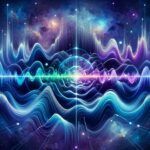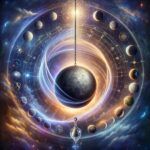Seven hermetic principles
10. December 2023

In this article, I challenge you to delve into seven ancient principles that can change your perception of yourself and your life!
I believe that much of the chaos we experience in the world today can be attributed to our collective memory loss of the principles that in ancient traditions bound everything and everyone together. We have forgotten that there is much more that connects us than separates us.
Admittedly – it may seem like a complicated and almost too profound a topic, but I have discovered that the more I understand where I come from, the better I can see through my own and other people’s patterns and complications. And that is something that helps me in my work as a coach and mindfulness instructor.
I must admit that I have had my reservations about sharing the content of this article. It is about seven ancient principles from Hermetic philosophy, and my hesitation is due to the warnings that often accompany the dissemination of this type of knowledge.
The term “hermetically sealed” originally refers to something that is completely and airtight sealed, as one would see in alchemical processes. Within Hermetic philosophy, it also symbolizes the idea of keeping wisdom and secrets away from those who are not initiated or prepared. Many proverbs that we use today without further thought about their origin actually stem from ancient times. In connection with sharing the seven Hermetic principles with the world, there is this warning:
“The lips of wisdom are closed except to the ears of understanding”. This means that deep, universal wisdom is only accessible to those who are ready to understand it. The old masters who held the key to the Hermetic teaching were careful about who they shared their knowledge with. The proverb “Do not cast pearls before swine” from the Gospel of Matthew reflects a similar thought: It warns not to waste wisdom on people who neither appreciate nor understand its value.
Thus warned, this article is precisely about ancient knowledge, which may not be fully understood in a modern context. Over the years, with great interest, I have studied ancient esoteric philosophies which have formed the basis of many religions and traditions. This extensive work has made me realize that in our contemporary society, we often have forgotten our roots. Despite the warnings from the old masters, I have decided to share their ancient knowledge with you today.
I sincerely hope that I am not “casting pearls before swine”.
The seven principles that I will now talk about have changed my way of perceiving myself and my environment, and I will try to tie these principles together with the practice of mindfulness in everyday life.
Why? Because I have a desire to motivate people to wake up and take back control in their lives and become the master of it.
MINDFULNESS
As a mindfulness teacher, I use my daily mindfulness practice to navigate through a personal challenge with gradual vision loss. Mindfulness helps me stay present now and discover the beauty of life in every moment, despite the slowly progressing change in my condition.
Mindfulness is the key to unlocking the way to use these seven principles in your daily life. In mindfulness training, you practice being fully present and engaged in the present moment without judging it or making it your adversary, and it allows you to wake up and influence the way your brain perceives your so-called reality.
Mindfulness originally comes from Buddhist teachings, and the seven principles I will now share come from ancient hermetic wisdom. Hermetic philosophy refers to an ancient tradition that has its roots in the writings associated with Hermes Trismegistus, a fusion of the Greek and Egyptian deities Hermes and Thoth, and is known for its search for hidden, esoteric knowledge. This knowledge is seen as the key to understanding the essence of the universe and humanity.
Hermeticism also emphasizes the importance of self-realization and spiritual growth through inner work, meditation, and self-reflection and strives to create a synthesis of various religious and philosophical systems. With its profound influence on various occult and mystical traditions, hermeticism represents a complex combination of spiritual, philosophical, and cosmological ideas that continue to inspire those seeking spiritual insight in today’s world.
I am one of these people!

But what does something so ancient have to do with the present?
That is exactly what I want to illuminate in this article, so please read on.
In 1908, a book “The Kybalion” was published, which focuses on conveying seven principles and their application in the individual’s spiritual journey, as well as how they can be used to understand and navigate the various aspects of life. It is considered a significant source for understanding hermetic thinking and has been a guide for many seeking deeper esoteric knowledge.
THE SEVEN HERMETIC PRINCIPLES
MENTALISM
CORRESPONDENCE
VIBRATION
POLARITY
RYTHM
CAUSE AND EFFECT
GENDER
1. THE PRINCIPAL OF MENTALISM

“Everything you experience in your life is interpretations in the mind.
Your thoughts and beliefs shape your reality.”
What you experience and sense from your environment are just signals that are processed in your brain. It is actually your mind that interprets these data and gives them meaning. This means that two people can experience the same event completely differently based on their individual interpretations and past experiences in life.
Your experience of reality is largely constructed by your thoughts, habits, and beliefs. So, for example, if you are convinced that the world is a dangerous place, then your experiences will likely reflect this belief. Everything you experience becomes a self-fulfilling prophecy, where your beliefs define your actions.
This principle, that thoughts create our reality, may be more concrete than you might think. In quantum physics, it has long been established that the observer’s (or experiencer’s) consciousness can influence the outcome of an event at a subatomic level. This has led to speculation that our thoughts in some way can shape our physical reality. In other words – that thoughts truly affect how the universe’s fundamental elements behave.
PRACTICAL RELEVANS OF THE PRINCIPLE OF MENTALISM
Mindfulness teaches you to observe your thoughts and beliefs without needing to identify with them. By practicing mindfulness, you can observe how your thoughts shape your reality and actively choose more positive and empowering interpretations.
You can practice conscious thinking and be aware of negative thoughts, replacing them with positive ones. This is what I call the STOP-SWAP-THOUGHT game in my book “Sentenced to Blindness – Now What?” – A Journey from Hopelessness Street to Possibility Road.
If it is true that our thoughts have a direct influence on our physical environment, it opens up a revolutionary understanding of life. It confirms what philosophers and sages have postulated for millennia: ‘You become what you think and focus on.’
2. THE PRINCIPLE OF CORRESPONDENCE

“As above, so below. As within, so without.”
Principle number two suggests that there is a deep connection between the macro and the micro – that there are recurring patterns and fractals at all levels. From atoms resembling miniature solar systems to the repetition of the same patterns in your own life, the solar system, the galaxy, and even among galaxies.
Just as patterns and laws apply in the vast universe, they also hold true for smaller entities, such as humans, cells, or even atoms.
For instance, the shape of a small branch on a tree might resemble the shape of the entire tree, or the way coastlines form at different scales can intriguingly create patterns that resemble each other. This principle implies that by understanding patterns at one level (either microscopic or macroscopic), you can gain insight into the patterns at another level.
You can use this principle to understand your place in the universe. To understand the external – the universe, society, relationships – you must first try to understand the internal universe – your own mind, feelings, and consciousness.
This principle teaches us that human actions, thoughts, and feelings are reflected in the external world, and therefore you are encouraged to change yourself internally if you wish to change something in your external world.
Although this thought originally comes from older philosophical and mystical systems, we see it again in modern science, especially in quantum physics, where similar patterns and connections are observed at different levels. For example, the phenomenon of ‘Entanglement’ has amazed scientists for decades. A phenomenon where particles become ‘entangled’ in such a way that the state of one particle immediately affects the state of another, regardless of the distance between them. This has led to considerations of coherence and connection across space and time.
PRACTICAL RELEVANS OF THE PRINCIPLE OF CORRESPONDENCE
This principle encourages you to become deeply aware of your inner experiences and shows you that your inner state is often reflected in your outer world. Through mindful reflection, you can discover how your personal experiences are connected to larger patterns, influencing your actions and interactions. By changing your inner state (your thoughts and feelings) with mindfulness principles, you can create positive changes in your external life.
3. THE PRINCIPLE OF VIBRATION

“Everything in the universe vibrates and moves. Nothing is at rest. Nothing is fixed or still. Everything is either on its way to or from something.”
At the most fundamental level, modern physics and quantum mechanics support the idea that everything in the universe is in constant motion. Atoms and subatomic particles are in a state of continuous vibration and movement, even in seemingly solid and stationary objects. Even in a tree and a stone, there is movement.
Science has known for 120 years that everything in the universe consists of energy in various forms and vibrations. Interestingly, the book where I discovered these seven principles was published in 1908. This suggests that this knowledge might be older than science recognizes. Scholarly circles may have known about the deeper structures of the universe long before modern science rediscovered these universal truths. Everything, from the smallest particles to the largest galaxies, vibrates with its own unique frequency, indicating that the natural state of the universe is constant change and transformation.
Like the universe, your life and your experiences are also in constant change, never in complete standstill.
A fundamental insight here is that change is an inevitable part of life. Recognizing that nothing is static helps you accept changes in your own life – both positive and negative. It can lead to a greater sense of peace and less resistance to life’s inevitable ups and downs.
Understanding that everything is in constant motion encourages you to appreciate the present more. Mindfulness practice, which focuses on being fully present in the moment, is supported by this realization. It helps you let go of focusing on the past, which you cannot change, and the future, which you cannot predict.
The idea that everything vibrates also leads to a deeper understanding of how you interact with the world around you. Your thoughts, feelings, and actions also emit a form of ‘vibration’ or energy, which can influence your experiences and relationships. Knowing this can motivate you to cultivate more positive thoughts and attitudes. That’s exactly what this insight has done for me.
The realization that everything is in motion has made me more flexible and strengthened my adaptability. By being open to change and adapting to new situations, you can navigate life more effectively and with greater peace.
PRACTICLE RELEVANS OF THE PRINCIPLE OF VIBRATION
What can you use this insight for? Having a ‘higher frequency’ is often associated with positive emotions such as compassion, appreciation, gratitude, and care. By cultivating these feelings, you can raise your vibration and thus approach a more enlightened state. Practices like meditation, yoga, mindfulness, and other forms of personal reflection and self-development help raise your frequency. Meditation promotes calm, inner peace, and a deep connection with the greater whole.
Therefore, be aware that your life is in constant change. It’s the law of nature. Are you clinging stubbornly to stagnation, or are you moving with the river of life’s energy? Where are you on the frequency scale? Are you energy or heavy matter?
By being mindfully present, you can raise your frequency. You can become more attuned to the vibrations of the universe, whether in meditation, music, or nature. With a higher frequency, you can ride the river of life’s changeability and make it your source of strength and resilience.
Compassion, appreciation, gratitude, and care are the codes that raise your frequency. Through this guided meditation, you can practice raising your frequency.
4. THE PRINCIPLE OF POLARITY

“Everything has its opposite. Heat and cold are the same phenomenon, but at different degrees.”
This thought reflects the idea of duality, which is fundamental in many philosophical, religious, and scientific traditions. Duality means that reality consists of opposites. Everything in the universe exists in opposition – light and dark, hot and cold, up and down. These opposites are not just separate and contrary phenomena, but exist as a unified whole.
For example, heat and cold are not different but are expressions of different levels of energy. Heat is an expression of a higher energy state (higher molecular movement), while cold is a lower energy state (less molecular movement). So, heat and cold are not opposites, but rather points at each end of a scale.
PRACTICAL RELEVANS OF THE PRINCIPLE OF POLARITY
What can you learn from this? Well – what is considered hot in one context may be considered cold in another. What may be considered sad in one context may be considered cheerful in another context. This emphasizes that many of your categorizations of your experience of the so-called “reality” are based on your beliefs and inner states of mind. Not reality itself. Reality is always an interpretation in your mind.
Thus, you can use the principle to understand conflicts and opposites. By understanding that opposites are often relative and part of a larger whole, you can achieve a deeper understanding and perhaps even Inner Peace in Outer Chaos.
When you experience extremes in emotions or situations, anger, joy, good, evil, remember that they are two sides of the same fundamental substance. Without darkness, you would not appreciate light. Without cold, you would not understand warmth. When you are drawn to one extreme, try to find balance. For example, if you feel overwhelmed, take time to relax and connect with your breathing and your body. If you feel sad, motivate yourself with a walk and movement. Seek balance and find the midpoint between extremes. This is what the ancient masters called mental alchemy. Being able to control your brain chemistry and create your reality with mental resources.
Mindfulness can teach you to observe extremes without needing to identify with them. You can observe them and breathe with them without becoming them, thus living in better harmony with life’s ups and downs.
5. THE PRINCIPLE OF RYTHM

“Everything has a rhythm or a cycle, just like the tide.”
This principle reflects a universal concept observable at many levels in nature and human experiences. Nature abounds with examples of so-called cyclical patterns: patterns that repeat themselves.
The tide is a clear example, driven by the gravitational forces of the moon and sun. The seasons change, and even biological processes like cell division and life cycles in plants and animals. On a cosmic scale, we also observe cyclical patterns, such as the orbits of planets around the sun and the rotation of galaxies.
In an old book from 1908 – The Kybalion – which explores Hermetic principles and philosophies, the image of a pendulum’s swing is used to illustrate the principle of rhythm. A pendulum moving back and forth between two extremes. Two poles.
In your life, this can be experienced as a cycle of good and bad times. Like a pendulum, which upon reaching one extreme, inevitably begins to move back towards the other, life’s circumstances shift between periods of happiness and challenges.
“The Kybalion” suggests that while the pendulum swings, its anchor point – the point from which it swings – remains stable. This can symbolize the importance of finding an inner balance or a center of calm, irrespective of external fluctuations.
Part of Hermetic wisdom involves understanding these natural rhythms and learning to work with them rather than against them. Finding ways to rise above the swings, so you are not so strongly affected by them. By becoming aware of life’s cyclical nature, you can better prepare for and handle change and uncertainty.
PRACTICAL RELEVANS OF THE PRINCIPLE OF RYTHM
Become aware of the natural rhythms in life (work/rest, sleep/wakefulness, the seasons). Plan your life in harmony with these rhythms instead of fighting against them.
Mindfulness teaches you to live in harmony with life’s natural cycles. Being aware of these rhythms – whether they are daily, seasonal, or life phases – helps you flow with them instead of resisting and fighting against them.
6. THE PRINCIPLE OF CAUSE AND EFFECT

“Nothing happens by chance; everything has a cause.”
Within the framework of Hermetic philosophy, the idea that nothing happens by chance is deeply rooted in a perception of the universe as a finely-tuned, interconnected system, where everything is connected. This philosophy emphasizes that every phenomenon, every event, and every aspect of your reality is the result of specific causes and connections, even if these may not be immediately apparent.
In this worldview, your actions and thoughts are not viewed as isolated or independent; rather, they are integrated parts of a larger network of cause and effect. Every thought you think, every word you speak, and every action you perform sends ripples through this network, affecting the surrounding environment and contributing to the collective reality.
PRACTICAL RELEVANS OF THE PRINCIPLE OF CAUSE AND EFFECT
Consider your actions carefully, as each action initiates a chain reaction. Be mindful of the consequences of your behavior. Before making a decision, consider the possible outcomes. Practice taking responsibility for your actions and their impact on others.
Mindfulness makes you more aware of your actions and their impact. You are trained to be thoughtful, to become conscious of your actions, and to take responsibility for their effect on your surroundings.
7. THE PRINCIPLE OF GENDER

“Both masculine and feminine qualities exist in everything.”
These energies must work together to create balance. In Eastern philosophies, particularly Taoism, the concept of Yin (feminine) and Yang (masculine) is essential. Yin represents passive, receptive, and introspective qualities, while Yang represents active, outgoing, and expansive qualities. These two forces are seen as fundamental to the dynamics of the universe and must be balanced to achieve harmony.
Carl Jung further developed this idea with his theory of archetypes in the collective unconscious, which included the masculine and feminine as fundamental aspects of human psychology. According to Jung, regardless of gender, every person has both masculine and feminine elements in their psyche. He argued that a fully developed, balanced personality requires acknowledging and integrating both of these aspects within oneself. This means that the development of your personal and spiritual qualities involves creating harmony and balance between these masculine and feminine energies.
PRACTICAL RELEVANS OF THE PRINCIPLE OF GENDER
Recognize both the masculine (rational, active) and feminine (intuitive, creative) aspects of yourself. Become conscious of balancing these energies in your personal and professional life.
In mindfulness training, you practice embracing both logic and intuition, action and reflection, and embodying the principle of balancing these energies.
CONCLUSION

I hope you’re still with me! Let’s summarize what we have discovered together.
As a conclusion to all these ancient esoteric philosophies and their relevance to the modern life we all live, it’s clear that the ancient wisdom traditions still have much to offer us today.
By exploring, understanding, and integrating these timeless principles – from recognizing that your experiences are subjective interpretations in the mind, to understanding that the universe is in perpetual motion and change through rhythm and vibration – you can gain a deeper understanding of both yourself and the world you live in.
You are encouraged to realize that you have far greater inner power to create the life you dream of by focusing your attention on what you want rather than what you don’t want.
Mindfulness is like a bridge that connects this ancient wisdom to your everyday life, enabling you to live more consciously, harmoniously, and balanced. This journey towards deeper self-insight and universal understanding is not just a path to your Possibility Road but also a path to healing and connecting our fragmented world.
Thank you for your attention.
Copyright, Morten Bonde, 2023.
All images are created with DALL-E.

1. THE PRINCIPAL OF MENTALISM
“Everything you experience in your life is interpretations in the mind. Your thoughts and beliefs shape your reality.”

2. THE PRINCIPLE OF CORRESPONDENCE
“As above, so below. As within, so without.”

3. THE PRINCIPLE OF VIBRATION
“Everything in the universe vibrates and moves.
Nothing is at rest. Nothing is fixed or still.
Everything is either on its way to or from something.”

4. THE PRINCIPLE OF POLARITY
“Everything has its opposite. Heat and cold are the same
phenomenon, but at different degrees.”

5. THE PRINCIPLE OF RYTHM
“Everything has a rhythm or a cycle, just like the tide.”

6. THE PRINCIPLE OF CAUSE AND EFFECT
“Nothing happens by chance; everything has a cause.”






